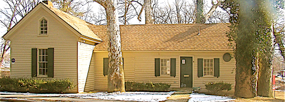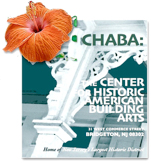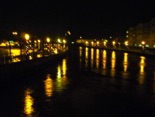Do not worry if you have built your castles in the air. They are where they should be. Now put the foundations under them.”
...Henry David Thoreau
Do not worry if you have built your castles in the air. They are where they should be. Now put the foundations under them.”
...Henry David Thoreau



![[chaba]](the_Bridgeton_Historic_District_files/shapeimage_4.png)



DISTRICT FOUND Historic architect Hugh McCauley (who had just helped Cape May reinvent itself through its own historic preservation movement) was let loose on Bridgeton in the late 1970s. Asked recently why he’d defined such a large district in Bridgeton, he said “I just kept on going till somebody told me to stop.” The approximately 2200-structure District was nationally registered in late 1982 and municipally registered in 1983.






DISTRICT LOST In the early millennium an area in Northgate along Cohansey Street was partially demolished for HOPE VI housing. Although the replacements are sympathetic to the district (and received a preservation award for infill design in 2011), the ownership culture planners hoped for has not materialized. Other neighborhoods have suffered some less systematic lost fabric and demolition, leaving gaps and “missing teeth.” Preservationists fear a slippery slope, as rentals dominate in traditionally moderate-income and working class neighborhoods, and house-proud maintenance loses priority over return on investment. Landlords with many properties also wield some political clout, making it more difficult for the City to enforce the historic ordinance.
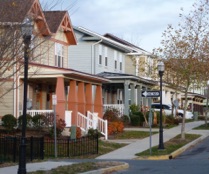

BRIDGETON’S HISTORIC DISTRICT...
The CHARM...
Bridgeton’s architectural range is encyclopedic: from cabin to castle, high Victorian to classical revival to modernist. The Historic District itself includes an amazing number of individual architectural gems, many designed by noted architects. But its character is perhaps defined overall by its counterpane of mostly well-crafted and largely residential structures in a variety of American vernacular styles, homes to the middle and working-class families of the city’s industrial boom-period.
The district “spine” runs east and west along Commerce Street. From East Lake to Pearl Street along East Commerce are well-preserved and distinctive late Colonial and Federal-period homes and churches and the dramatically opposed facades of City Hall and City Hall Annex. An array of slightly later high Victorians, Eastlakes and gabled and porched Queen Annes front West Commerce and Lake Streets. Together they form an “EastSide/West Side” historic corridor joined by the central commercial district, perfect symmetry for the city’s annual House Tour in early December.
...and the CHALLENGE
Bridgeton’s huge district includes a number of still-intact streetscapes in all its parts, some with showstoppers of period architecture. But the challenge of managing so large and varied an historic district is essentially defined by conditions affecting its East Lake, Northgate and Southgate sub-districts (those outlined in red, purple and yellow on the District Map to the right).
Here streetfronts of similar woodcrafted homes, notable largely for their distinctive gingerbread porches and whimsical craftsmanly touches, have become essential housing for migrant worker families, often in overcrowded conditions. The houses , like the families, perform a critical service in our lopsided, often exploitative economy. But their historic features are not seen as part of their economic value.
Yet we believe they still have this potential--for both their present owners and the upwardly mobile families who live in them.
THE STORIES A STREETSCAPE CAN TELL
The beauty of this housing stock is not just its durability and adaptability over generations, but its power as part of an ongoing story. These were the “Facebook” of another generation of workers. Each was an owner-created signature page sporting a specially-designed bracket, corbel, or pillar, a railing or window eyebrow, and finished with a flair of craftsmanship--a repeated gingerbread “logo” or scalloped shingle, a piece of framing or touch of decorative glass.
Each signature said, with quiet conviction: We are Americans--though such Americanness might sometimes have been more a hope than a present reality--the intrinsic promise of the next generation. We have a LOT in common. But we are NOT the same.
Gingerbread: we think it is fine art--now. But then it was the accessible art of the striver who could not afford marble or stone or the skills that came with crafting such materials. And so this style became American, almost by definition, with nothing quite like it anywhere else in the world.
We can tease many other community narratives from these house-fronts. Short setbacks and narrow separating carriageways declare the modest life-styles of their owners. And many are “doubles,” side-by-sides under a single roof--a feature of Bridgeton’s moderate-income bousing stock that suggests another role housing played both in creating types of communities and in mixing socioeconomic strata.
Race remained a divider. The neighborhood known as Southgate was traditionally African American, and stood (and still stands) on the Fairton/Gouldtown boundary, away from the city center. But it is surprising how little all these wider neighborhoods were ghettoized by income when they were new. Houses of very different size and display were often built on the same block. A mother and married daughter might live side by side In those “doubles,” but so did unrelated owners and renters.
They still do, as immigrant agricultural workers and their families “make it,” they too are buying an affordable double and renting or sharing the partner living quarters.
Shared responsibility:
Everywhere, and in every walk of life, shared responsibility represents both a blessing and a challenge. Community design standards, a contemporary tradition developed in western states, has not typically gained ground in the East, putting preservationists here at some disadvantage.
For our vernacular streetscapes, one kind of challenge is preserving the integrity of a separately-owned single facade. Another is retaining (or reclaiming) the integrity of the streetscape as a whole. Both mean bringing together not just an esthetic but an ethic of cooperation or collaboration. An ethic that must extend to the wider community if it is to have any influence on the quality of people’s lives.
It appears to have done this at least once here in Bridgeton.
We think it can do it again.

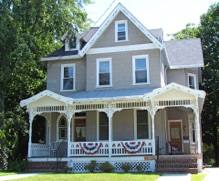


STREETSCAPE “FACEBOOK”
“Like” this?
Pictured here: a handful of the hundreds of unique “gingerbread” designs along the “HomeFronts” of Bridgeton’s large Historic District.

CAN WE LEGISLATE COOPERATION?
(Above) Examples of differing treatments of separately-owned sides of the classic Bridgeton “double”; (below) the Bridgeton streetscape with common setbacks. Both vernacular traditions represent special challenges and opportunities for community, communication and collaboration.




the Center for Historic American Building Arts
ReVisioning New Jersey's Largest Historic District
31 West Commerce Street
Bridgeton, NJ 08302
English: 856-221-3276
Español: 856-221-3239
cell: 201-321-3813
[chaba]
